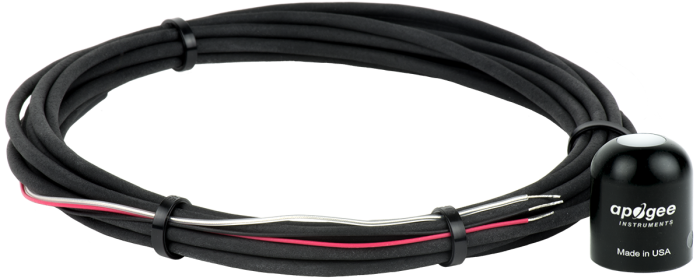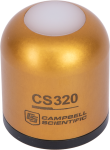This product is no longer available and has been replaced by: CS301. Some accessories, replacement parts, or services may still be available.

| Services Available |
|---|
Overview
The CS300, manufactured by Apogee Instruments, measures total sun and sky solar radiation for solar, agricultural, meteorological, and hydrological applications. Its spectral range of 360 to 1120 nanometers encompasses most of the shortwave radiation that reaches the Earth's surface. This pyranometer connects directly to our dataloggers. Its output can be measured by all of our dataloggers.
Read MoreBenefits and Features
- Compatible with most Campbell Scientific data loggers
- Designed for continuous, long-term, unattended operation in adverse conditions
- Measurement waveband of 360 to 1120 nm
- Dome-shaped head prevents water from accumulating on the sensor head
Images




Related Products
Technical Description
The CS300 uses a silicon photovoltaic detector mounted in a cosine-corrected head to provide solar radiation measurements for solar, agricultural, meteorological, and hydrological applications. Calibrated against a Kipp & Zonen CM21 thermopile pyranometer, the CS300 accurately measures sun plus sky radiation for the spectral range of 360 to 1120 nm. Sensors calibrated to this spectral range should not be used under vegetation or artificial lights.
The standard output is 0.2 mV per W m-2, which provides a signal of 200 mV in full sunlight (1000 W m-2). All of our dataloggers, including the CR200(X) series, can measure this output.
Compatibility
Please note: The following shows notable compatibility information. It is not a comprehensive list of all compatible products.
Dataloggers
| Product | Compatible | Note |
|---|---|---|
| 21X (retired) | ||
| CR10 (retired) | ||
| CR1000 (retired) | ||
| CR1000X (retired) | ||
| CR10X (retired) | ||
| CR200X (retired) | ||
| CR211X (retired) | ||
| CR216X (retired) | ||
| CR23X (retired) | ||
| CR300 (retired) | ||
| CR3000 (retired) | ||
| CR310 | ||
| CR500 (retired) | ||
| CR5000 (retired) | ||
| CR510 (retired) | ||
| CR6 | ||
| CR800 (retired) | ||
| CR800 (retired) | ||
| CR850 (retired) | ||
| CR850 (retired) | ||
| CR850 (retired) | ||
| CR850 (retired) | ||
| CR9000 (retired) | ||
| CR9000X (retired) |
Additional Compatibility Information
Sensor Mounts
Accurate measurements require the sensor to be leveled using a 18356 leveling fixture. This leveling fixture incorporates a bubble level and three adjusting screws. The 18356 mounts to a crossarm or a tripod or tower mast using the CM225 mounting stand. The CS300 should be mounted away from all obstructions and reflective surfaces that might adversely effect the measurement.
Data Logger Considerations
One differential analog input channel per probe is required.
Specifications
| Spectral Range | 360 to 1120 nm (wavelengths where response is 10% of maximum) |
| Measurement Range | 0 to 2000 W/m2 (full sunlight ≈1000 W/m2) |
| Absolute Accuracy | ±5% for daily total radiation |
| Sensitivity | 5 mV/Wm-2 |
| Calibration Factor | 5 W/m2/mV |
| Cosine Correction Error | ±5% at 75° zenith angle; ±2% at 45° zenith angle |
| Temperature Response | 0.04 ± 0.04% per °C |
| Response Time | < 1 ms |
| Long-Term Stability | < 2% per year |
| Operating Temperature Range | -40° to +70°C |
| Relative Humidity Range | 0 to 100% |
| Output Sensitivity | 0.2 mV/W/m2 |
| Diameter | 2.4 cm (0.9 in.) |
| Height | 2.5 cm (1.0 in.) |
| Weight | 65 g (2.3 oz) with 2-m (6.6-ft) lead wire |
Related Documents
Product Brochures
Manuals
Related FAQs
Number of FAQs related to CS300-L: 2
-
Most Campbell Scientific sensors are available as an –L, which indicates a user-specified cable length. If a sensor is listed as an –LX model (where “X” is some other character), that sensor’s cable has a user-specified length, but it terminates with a specific connector for a unique system:
- An –LC model has a user-specified cable length for connection to an ET107, CS110, or retired Metdata1.
- An –LQ model has a user-specified cable length for connection to a RAWS-P weather station.
If a sensor does not have an –L or other –LX designation after the main model number, the sensor has a set cable length. The cable length is listed at the end of the Description field on the product’s Ordering tab. For example, the 034B-ET model has a description of “Met One Wind Set for ET Station, 67 inch Cable.” Products with a set cable length terminate, as a default, with pigtails.
If a cable terminates with a special connector for a unique system, the end of the model number designates which system. For example, the 034B-ET model designates the sensor as a 034B for an ET107 system.
- –ET models terminate with the connector for an ET107 weather station.
- –ETM models terminate with the connector for an ET107 weather station, but they also include a special system mounting, which is often convenient when purchasing a replacement part.
- –QD models terminate with the connector for a RAWS-F Quick Deployment Station.
- –PW models terminate with the connector for a PWENC or pre-wired system.
-
Many Campbell Scientific sensors are available with different cable termination options. These options include the following:
- The –PT (–PT w/Tinned Wires) option is the default option and does not display on the product line as the other options do. The cable terminates in pigtails that connect directly to a datalogger.
- In the –C (–C w/ET/CS110 Connector) option, the cable terminates in a connector that attaches to a CS110 Electric Field Meter or an ET-series weather station.
- In the –CWS (–CWS w/CWS900 Connector) option, the cable terminates in a connector that attaches to a CWS900-series interface. Connection to a CWS900-series interface allows the sensor to be used in a wireless sensor network.
- In the –PW (–PW w/Pre-Wire Connector) option, the cable terminates in a connector that attaches to a prewired enclosure.
- In the –RQ (–RQ w/RAWS Connector) option, the cable terminates in a connector that attaches to a RAWS-P Permanent Remote Automated Weather Station.
Note: The availability of cable termination options varies by sensor. For example, sensors may have none, two, or several options to choose from. If a desired option is not listed for a specific sensor, contact an application engineer at Campbell Scientific for assistance.
Case Studies
Dr. Joan Girona of the Institute of Agroalimentary Research and Technology in Catalonia, Spain, studies......read more

